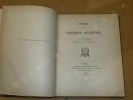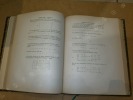BRIOT Charles
Théorie des fonctions abéliennes.
1879 Gauthier-Villars, 1879, 181 p., demi-maroquin rouge, cuir de la reliure salie, bords des plats frottés, une déchirure sans manque dans la marge de la page d'errata, sinon intérieur propre.
Reference : 89371
Merci de nous contacter à l'avance si vous souhaitez consulter une référence au sein de notre librairie.
Bookseller's contact details
Librairie Diogène
Mme Claire Dulac
29 rue saint jean
69005 Lyon
France
33 04 78 42 29 41
Payment mode



Sale conditions
Les ouvrages sont payables à la commande. Nous acceptons les règlements par chèque, virement, ou carte bancaire. Les paiements doivent être effectués en euros. En raison des frais bancaires, les paiements en devises étrangères seront majorés d'une somme de 25 euros. Les frais de port et d'assurance sont à la charge de l'acheteur. En cas d'envoi simple, sans suivi ni assurance, c'est l'acheteur qui est responsable. Une estimation des frais de port peut être faite sur simple demande, pour un ouvrage et une destination donnés. ATTENTION : les livres proposés sur le site ne sont pas directement accessibles à la Librairie. Merci de nous contacter à l'avance si vous souhaitez les consulter au magasin.
5 book(s) with the same title
Théorie des fonctions abéliennes.
Paris, Gauthier-Villars, 1879. In-4, XIX-181, Broché, couverture imprimée.
Au moment de la publication de Briot, la théorie des fonctions abéliennes en était encore à ses débuts, avec les contributions de mathématiciens comme Abel, Jacobi et Riemann. Les fonctions abéliennes sont une généralisation des fonctions elliptiques et sont étroitement liées à la théorie des intégrales des courbes algébriques. Les travaux de Briot ont joué un rôle déterminant dans la formalisation de l’étude de ces fonctions, notamment en étendant l’idée de fonctions à valeurs multiples et en fournissant de nouveaux outils pour travailler avec les fonctions à valeurs multiples. M8-B
Théorie des fonctions abéliennes.
Paris, Gauthier-Villars, 1879.
Première édition. "Ce volume peut-être considéré comme la suite de celui que nous avons publiés, M. Bouquet et moi, il y a plusieurs années sous le titre de "Théorie des fonctions elliptiques. "Briot also published (...) a treatise on Abelian functions (1879). The Académie des Sciences awarded Briot the Poncelet Prize in 1882 for his work in mathematics". DSB 2, 470. Bel exemplaire, à l'état de parution. /// In-4 de XIX, 181, (1) pp. Broché, couverture imprimée. //// /// PLUS DE PHOTOS SUR WWW.LATUDE.NET
QUATRE TIRES-A-PART (OFF-PRINT) de Charles HERMITE reliés en un volume : 1. SUR la théorie de la transformation des fonctions abéliennes. Tiré à part des Comptes-rendus de l'Académie des sciences, tome 40. P., 1855, 34pp. - 2. SUR quelques développements en série de fonction de plusieurs variables. Tiré à part des Comptes-rendus de l'Académie des sciences, tome 60. P., s.d., 26pp. - 3. SUR un nouveau développement en série des fonctions. Tiré à part des Comptes-rendus de l'Académie des sciences, tome 58. P., 1864, 8pp. - 4. SUR la théorie des formes quadratiques. Tiré à part des Comptes-rendus de l'Académie des sciences, tome 55. P., 1862, 8pp
P., 1855/1864,un volume in 4 relié en pleine toile noire (reliure postérieure), (quelques rousseurs)
---- EDITION ORIGINALE ---- "In 1862, through Pasteur's influence, a position of Maître de conférence was created for Hermite at the Ecole Polytechnique. He occupied that position until 1869, when he took over J.M.C. Duhamel's chair as professor of analysis at the Ecole Polytechnique and at the Faculté des Sciences. His textbooks in analysis became classics, famous even outside France... Throughout his lifetime and for years afterward Hermite was an inspiring figure in mathematics. His work exerted a strong influence in his own time, but in the twentieth century a few historians, at most, will have cast a glance at it... He is remembered chiefly in connection with Hermitean forms, a complex generalization of quadratic forms and with Hermitean polynomials. His name also occurs in the solution of the fifth-degree equation by elliptic functions. He first proved the transcendence of e. If Hermite's work were scrutinized more closely, one might find more instances of Hermitean preludes to important discoveries by others...". (DSB VI p. 307)**2648/N4
Sur la théorie de la transformation des fonctions abéliennes. ( I,II,III a. IV,V,VI). 2 papers.
(Paris: Gauthier-Villars), 1855. 4to. No wrappers. In: ""Comptes Rendus Hebdomadaires des Seances de l'Academie des Sciences"", Vol 40, No 5 + 6. Pp. (205-) 260 a. pp. (261-) 324. (2 entire issue offered). Hermite's paper's: pp. 249-256 a. 304-309.
First printing of Hermite's importent paper in which he created the theory of transformations.""Another topic on which Hermite worked and made important contributions was the theory of quadratic forms. This led him to study invariant theory and he found a reciprocity law relating to binary forms. With his understanding of quadratic forms and invariant theory he created a theory of transformations in 1855. His results on this topic provided connections between number theory, theta functions, and the transformations of abelian functions.""""Hermite’s 1855 results became basic for the transformation theory of Abelian functions as well as for Camille Jordan’s theory of ""Abelian"" groups. They also led to Herrnite’s own theory of the fifth-degree equation and of the modular equations of elliptic functions.""(DSB).
L'oeuvre mathématique de Weierstrass (+) Sur les Propriétes du potentiel et sur les Fonctions Abéliennes [Poincaré] (+) Sur la Théorie des Variations des Latitudes [Poincaré].
Berlin, Stockholm, Paris, Beijer, 1899. 4to. Bound in contemporary half cloth with gilt lettering to spine. In ""Acta Mathematica"", Vol, 22, 1899. Entire volume offered. Stamps to title page, otherwise a fine and clean copy. pp. 1-18" Pp. 89-178" Pp. 201-358.[Entire volume: (4), 388, 2 pp].
First printing of these important papers: POINCARÉ: First edition. ""As soon as he came into contact with the work of Riemann and Weierstrass on Abelian Functions and algebraic geometry, Poincaré was very much attracted by those fields. His papers on these subjects occupy in his complete works as much space as those on automorphic functions, their dates ranging from 1881 to 1911. One of his main ideas in these papers is that of ""reduction"" of Abelian functions. Generalizing particular cases studied b Jacobi, Weierstrass, and Picard, Poincaré proved the general ""complete reducibility"" theorem...""(DSB).VOLTERRA: First edition. As the north and south poles, instead of being fixed points on the earth's surface, wander round within a circle of ab. 5o ft. in diameter, the result is a variability of terrestial latitudes generally. Volterra gives an elaborate mathematical analysis of these yearly fluxtuations.
 Write to the booksellers
Write to the booksellers






